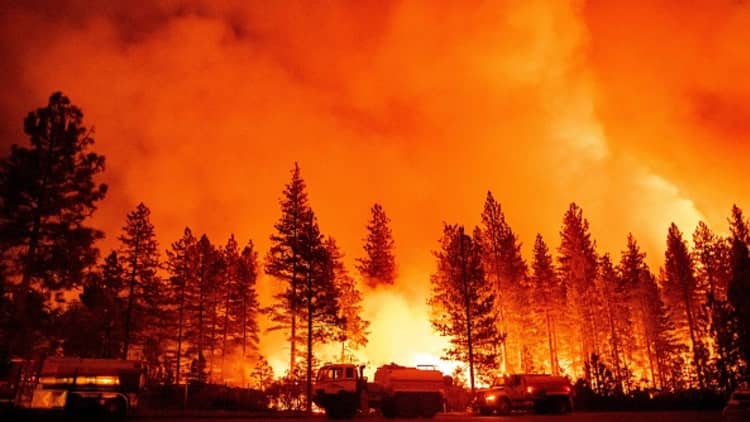Eduardo Munoz Alvarez | Getty Images
While both renters and homeowners are beginning to take climate hazards into consideration, affordability continues to drive moving trends.
Between 2021 and 2022, about 1.2 million more homeowners and renters moved out of than moved into U.S. cities with high risk of poor air quality, according to a new analysis by Redfin, a real estate firm. Metros with low risks of poor air quality saw 1 million more newcomers in the same timeframe.
“At an individual level, we know that people respond to climate risks and it impacts the decision of exactly what home to buy,” said Daryl Fairweather, chief economist of Redfin.
Researchers at Redfin analyzed domestic migration data from the U.S. Census Bureau and air quality risk scores from First Street Foundation, a nonprofit climate research organization based in New York.
More from Personal Finance:
How more supply is helping rent prices cool
More than 18 million rental units at risk from climate hazards
Renters are most exposed to climate hazards in these two states
First Street labels a metro as “high risk” when at least 10% of properties fall into the major, severe or extreme categories. A “low risk” metro is where less than 10% of properties fall into those categories.
The rating system is based on the number of poor air quality days expected within the next 30 years and it includes two common pollutants: particulate matter (which often comes from wildfire smoke) and ozone, (when pollutants react with heat or light).
Air quality and affordability are pushing residents out of 13 metros areas, many on the West Coast. Most of the inbound moves are heading into Sunbelt states like Arizona, Florida, Nevada, North Carolina, South Carolina, Texas and Tennessee. Yet, movers will confront different climate hazards in those areas, said Fairweather.
Much of the Sunbelt “has [a] low air-quality risk but it has high heat risk, high flood risk, high wind risk from things like hurricanes,” she said.
‘We’re already starting to see some shifts’
People are responding to the danger of climate-related risks, Jeremy Porter, head of climate implications research for First Street Foundation, a nonprofit organization in New York, previously told CNBC.Â
“We’re already starting to see some shifts in population where people, as they can, they’re moving away from risk and the people that can’t afford to move away from risk are stuck in those risky areas,” said Porter.
When looking at moving trends within counties and cities from 2000 to 2020 paired with flood risks, researchers at First Street Foundation noticed clear signals of people moving away from areas exposed to flooding.

In total, there are more than 2.9 million census blocks or neighborhoods in the U.S. that have levels of flood risk that are above the “tipping point,” or when flood risks begin to outweigh the area’s benefits, like job markets or proximity to the coast.
Nearly 818,000 neighborhoods in the U.S. experienced a population decline of more than 9 million people from 2000 to 2020, First Street found. Additionally, more than 3.2 million (35.5%) of those residents said they left specifically because of the flood risk.
‘I personally was impacted by air quality’
Over 85% of homes in 13 major cities are highly exposed to poor air quality; nine are in California and the rest are spread out in Washington, Oregon and Idaho, Redfin found.
“I personally was impacted by air quality,” Fairweather said. She and her family used to live in Seattle, before the Covid-19 pandemic.
But in September 2020, a major smoke event in the city due to wildfires motivated her to relocate her family to Wisconsin. While the smoke lasted two weeks in Seattle, Fairweather and her family decided not to move back.
“Climate change is definitely a factor and it was like the straw that broke the camel’s back,” she said. But as with many people, it wasn’t the only reason they decided to relocate.
On top of the poor air quality, many residents are leaving these areas because they’re being priced out; home prices in riskier metros are 65% higher than prices in low risk metros, according to Redfin.
Affordability remains as a priority for movers
About 83% of would-be homebuyers considered at least one climate risk when shopping for a home, Zillow Group, a real estate site, found in September.
Yet, some places continue to grow in population despite the underlying hazards. “Risky growth areas” are places with high levels of flood risk but continue to see population growth. Such places saw a population increase of about 17.6 million, or 30% of the country’s population, according to First Street research.
As housing costs linger at record highs, factors like affordability and employment opportunities remain as top priorities for buyers and renters alike, said Fairweather.
“It’s going to become more and more important every year, I think people will increasingly seek out information about climate risks when buying a home,” she said.
If not already, insurance costs will likely be a way many people first reckon with climate risk, said Fairweather.
Insurance bills could go up if a resident is based in a place that is exposed to increasingly common risks, and in some markets, insurers are pulling back on coverage.
“That is already happening in California, Texas and Florida. It could impact even more places,” she said.
Did you move recently because of a recurring climate hazard or weather risk? Email me at [email protected].







